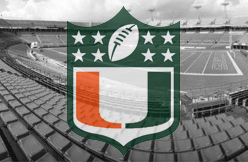OWINGS MILLS, Md. - Matt Birk had just wrapped up his question-and-answer session with the media Wednesday at the Baltimore Ravens’ indoor practice facility. Glancing behind him, Birk saw that teammate Ray Lewis was next in line to take the microphone.
“Heeeere’s Ray Lewis,’’ Birk said, giving the Pro Bowl linebacker a showman’s introduction.
Then, raising his hands and connecting them at the thumbs so that they formed a large letter “U,’’ Birk reminded everyone where Lewis played college football.
“He’s from ‘The U,’ ’’ said Birk, the veteran center.
Leave it to a Harvard man to spell it out.
“I’m still trying to get an ‘H,’ but I can’t figure out how you do that with your hands,’’ Birk joked.
The ubiquitous “U’’ hand signal has become a calling card of sorts for those NFL players who hail from the University of Miami. But it represents more than just a show of school spirit. It is a legacy of pride and passion upheld by those who have toiled - and still toil - in the South Florida heat and humidity, playing for the Hurricanes.
“Oh yeah, it’s just a history, man,’’ Lewis said. “It’s just a legacy of great players. These guys have been around a long time. Hurricanes come and they go.’’
Said Birk, “They’re a tight-knit group, all those guys, you know? They’re proud of where they went, and rightfully so.’’
Today, when the Patriots host the Ravens in a wild-card playoff matchup at Gillette Stadium, there will be six members of “The U’’ on hand, with nose tackle Vince Wilfork and safety Brandon Meriweather dressing for New England and linebackers Tavares Gooden and Lewis, safety Ed Reed, and running back Willis McGahee for Baltimore. They are among 14 Miami players listed on NFL playoff rosters this year, 10 of whom are starters, seven headed to the Pro Bowl.
“You’ll see a young Vince Wilfork over there and you’ll see a Meriweather over there,’’ said Lewis. “Anytime I’m on the field, I’m ‘Pops.’ But these are babies that you watched pretty much your whole career.’’
No matter what side of an NFL field they find themselves on, Hurricanes share a bond, a respect for one another, and pride in where they’re from.
“When we play against those players, we’re not out to hurt those guys,’’ McGahee said. “We’re out to beat ’em, but we’re not out to hurt ’em. Now, if we’re playing against somebody from Florida State? Aw, man, we don’t care anything about you.
“But I remember playing against Ray when I was in Buffalo and he tackled me and he was like, ‘C’mon young ’Cane, get up young ’Cane!’ ’’ McGahee recalled. “When I play against [Jonathan] Vilma [of the Saints], me and Vilma played together in school but we had this rivalry. It’s not like we hated each other, but it was like, ‘I’m gonna outdo you today,’ or he was trying to get a big hit on me.
“But at the end of the day, we always come back and it’s, ‘Good job, I’ll getcha next time.’ ’’
When the Patriots beat the Ravens, 27-21, Oct. 4 at Gillette Stadium, Meriweather was the best safety from “The U’’ on the field that day, better even than his mentor, Reed.
“He’s like my big brother, man,’’ Meriweather said. “Whenever I need advice or whenever I’m playing bad and I need someone to talk to, he’s always the one I call. He’s always been there with good advice.
“It’s like family playing against family - whenever you get a chance to play against family, you always want to win, so when you go home you have something to talk about.’’
In the mid-to-late ’80s, the Hurricanes were a force. Back then, it seemed, winning national championships was strictly “A ’Cane Thing,’’ with Miami capturing three of its five titles in 1987, 1989, and 1991. That dominance reflected Miami’s impressive assemblage of talent, which at first was culled largely from the stocked talent pools in South Florida.
“It’s a football program that’s had a lot of success and turned out a lot of good players,’’ Birk noted. “A lot of good pros.’’
Four went on to be immortalized in the Pro Football Hall of Fame, beginning with Jim Otto in 1980. He was followed by Ted Hendricks in 1990, Jim Kelly in 2002, and Michael Irvin in 2007.
“I don’t know who the Godfather of The U was, because you had a lot of them,’’ McGahee said. “You had Jerome Brown, you got Cortez Kennedy, you got Warren Sapp, you got Ray Lewis, and Michael Irvin, people like that. There’s a lot of great players. Bernie Kosar . . . Jim Kelly . . . Vinny Testaverde.
“You just can’t single any one person out at The U. That’s why we say it’s The U.
“When we hold up that ‘U,’ everybody knows what time it is: ‘Oh, he went to the University of Miami. You can’t say that anywhere else. It’s all about The U.
“At one point in life, everybody wanted to go to the University of Miami. I don’t care if it was even for a day or two. It was because of the colors we were, or the visors I wore - everybody wanted to be a part of it at one point.’’
For those who were, and still are, a part of that football fraternity, there remains a strong need to uphold their school’s reputation.
“It’s an honor,’’ Lewis said. “That’s why when the game is over - win, lose, or draw on each side - you got to go over and congratulate the other one, because that’s the way we’re built.
“It’s just like back when we were on the schoolyard in college, when we competed against each other. We’d do whatever we had to do to win, but after the day is over, then it’s over, and we’re back to being brothers.’’

(boston.com)



